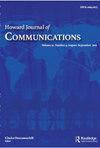阿格普,所罗门与绝望:yeililam电影中非穆斯林表现的内容分析
IF 0.8
Q3 COMMUNICATION
引用次数: 1
摘要
1956年至1975年间,土耳其电影制作蓬勃发展。这二十年也是非穆斯林角色出现在各种作品中的最后几年,所以他们提供了一个重要的窗口,让我们了解这一时期土耳其电影中非穆斯林的表现,被称为ye本文章由计算机程序翻译,如有差异,请以英文原文为准。
Agop, Salomon and Despina: Content Analysis of Non-Muslim Representations in Yeşilçam Cinema
Abstract In the years between 1956 and 1975, Turkish film production boomed. These two decades were also the very last years in which non-Muslim characters were still appearing in a wide range of productions, and so they offer an important window into the representation of non-Muslims in the Turkish cinema of this period, known as Yeşilçam. This essay explores these representations by analyzing 82 films featuring 121 Turkish Greek, Armenian and Jewish characters. The representation of these non-Muslims is considered through the characters’ importance to the plot, their names, genders, manners, ways of speaking, occupations, families, religious activities, relationships with Turkish Muslim characters, and the stereotypes associated with them. Unsurprisingly, non-Muslim characters often occupy minor, one-dimensional – and sometimes threatening – roles as these films are concerned with the stories of Turkish Muslim characters, who not only comprise the dominant group in society but also the vast majority of the audience. Analysis of the films indicates that representations of non-Muslim characters that originate in traditional Turkish art forms have undergone considerable change in films due to the influence of increasing Turkish nationalism, together with the Turkification policies of the Turkish state.
求助全文
通过发布文献求助,成功后即可免费获取论文全文。
去求助
来源期刊

Howard Journal of Communications
COMMUNICATION-
CiteScore
2.70
自引率
10.00%
发文量
23
期刊介绍:
Culture, ethnicity, and gender influence multicultural organizations, mass media portrayals, interpersonal interaction, development campaigns, and rhetoric. Dealing with these issues, The Howard Journal of Communications, is a quarterly that examines ethnicity, gender, and culture as domestic and international communication concerns. No other scholarly journal focuses exclusively on cultural issues in communication research. Moreover, few communication journals employ such a wide variety of methodologies. Since issues of multiculturalism, multiethnicity and gender often call forth messages from persons who otherwise would be silenced, traditional methods of inquiry are supplemented by post-positivist inquiry to give voice to those who otherwise might not be heard.
 求助内容:
求助内容: 应助结果提醒方式:
应助结果提醒方式:


